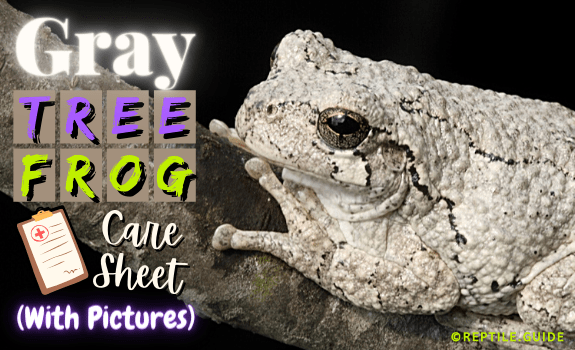Gray tree frogs are prevalent and widespread North American frogs. Despite their numbers, most people only get to see them during the breeding season.
Spring nights in wooded areas are often flooded with the chorus of competing male gray tree frogs. You may recognize them by their bright yellow leg markings as they jump away.
The common name, gray tree frog, accounts for two species with overlapping ranges: Dryophytes versicolor or Hyla versicolor and Hyla chrysoscelis.
Join us as we discuss the natural history, fun facts, and amazing survival adaptations of this overlooked species. You’ll even learn how to care for them, should you decide you need some in your life!
In This Article
Facts at a Glance
|
Common Name |
Gray Tree Frog |
|
Scientific Name |
Dryophytes versicolor or Hyla versicolor and Hyla chrysoscelis |
|
Adult Size |
1.5 – 2 inches |
|
Native Range |
Eastern United States (as far west as central Texas and Oklahoma) and southeast Canada. |
|
Lifespan |
5-7 Years |
|
Natural Diet |
Tadpoles: Algae and detritus Frogs: Mites, spiders, ants, and snails. |
|
Natural Habitat |
Wooded areas near temporary or permanent water sources |
|
Do They Make Good Pets? |
Yes |
|
Minimum Enclosure Dimensions |
12″ x 12″ x 18″ (L x W x H) |
|
Temperature |
68-78℉ |
|
Humidity |
50-80% |
Cope’s Gray Tree Frog vs. Eastern Gray Tree Frog
The Cope’s gray tree frog (Hyla chrysoscelis) and the eastern gray tree frog (Dryophytes versicolor or Hyla versicolor) are two visually indistinguishable species.
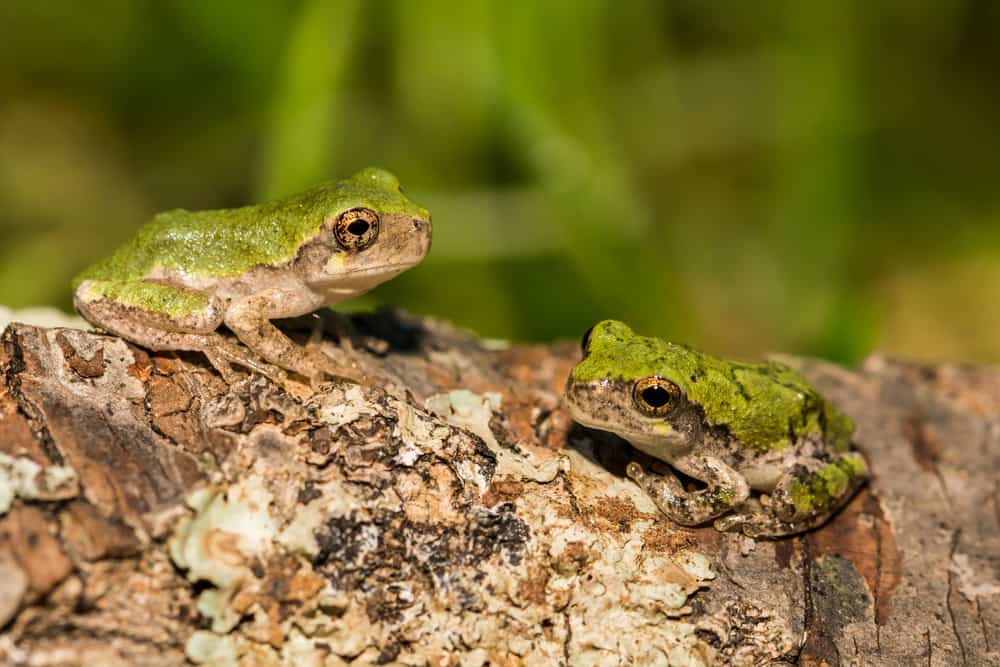
Cope’s gray tree frogs tend to prefer the southern end of their native range, but even that isn’t a reliable identifier.
Genetically speaking, Cope’s gray tree frogs have diploid cells containing two chromosomes, similar to humans.
Eastern gray tree frogs have four sets of chromosomes in each cell. That’s why they’re also known as the tetraploid gray tree frog.
Did You Know? Despite their chromosomal differences, Cope’s gray tree frogs and eastern gray tree frogs can reproduce. Similar to other organisms with chromosomal abnormalities, hybrid tree frogs rarely survive to adulthood. If they do, they’re usually infertile.
The primary outward difference between these two species is the males’ calls.
Cope’s gray tree frogs have faster calls with 34 to 60 pulses per second.
Eastern gray tree frogs average 16 to 34 pulses per second.
Yet, still, differentiating these species is no easy task. Colder weather may result in slower calling, causing Cope’s gray tree frogs to sound like eastern gray tree frogs.
In terms of behavior, appearance, and husbandry practices – Cope’s gray tree frogs and eastern gray tree frogs are the same. It’s best to leave further specifics in the hands of scientists.
Gray Tree Frog Size and Appearance
Average Adult SVL Length: 1.5 to 2 inches
Fun Fact: “SVL” is a common abbreviation used by herpetological professionals. It stands for “snout-to-vent length.” SVL is a standardized method for measuring reptiles and amphibians. Tail and limb loss can drastically impact an animal’s overall length, so SVL is more reliable and accurate for determining average population sizes.
When tadpoles metamorphosize into froglets, they’re around half an inch long. They take one to two years to reach their full size.
Their growth rate is highly dependent on food availability and climate. As adults, females are roughly 25% larger than males. The record length of an adult female was 2.36 inches.
During the breeding season, only males call, and they may display their dark throat patch. Females don’t vocalize, and they don’t have a colored throat patch.
Gray tree frogs can range from nearly black to nearly white. They’re even capable of changing to light green, yellow, or gray – as their name implies.
Their skin has varying degrees of mottling. The pattern helps them blend in as a patch of moss or even a bird’s droppings.
Their legs often have grayish purple bands. The folds of their arms and legs also feature bright-yellow coloration with black markings.
Those striking colors are only visible when the frog stretches out. Don’t be surprised by the flashes of bright yellow when a gray tree frog is mid-jump!
Unlike most frogs, gray tree frogs have bumpy, warty skin. That doesn’t mean they’re toads.
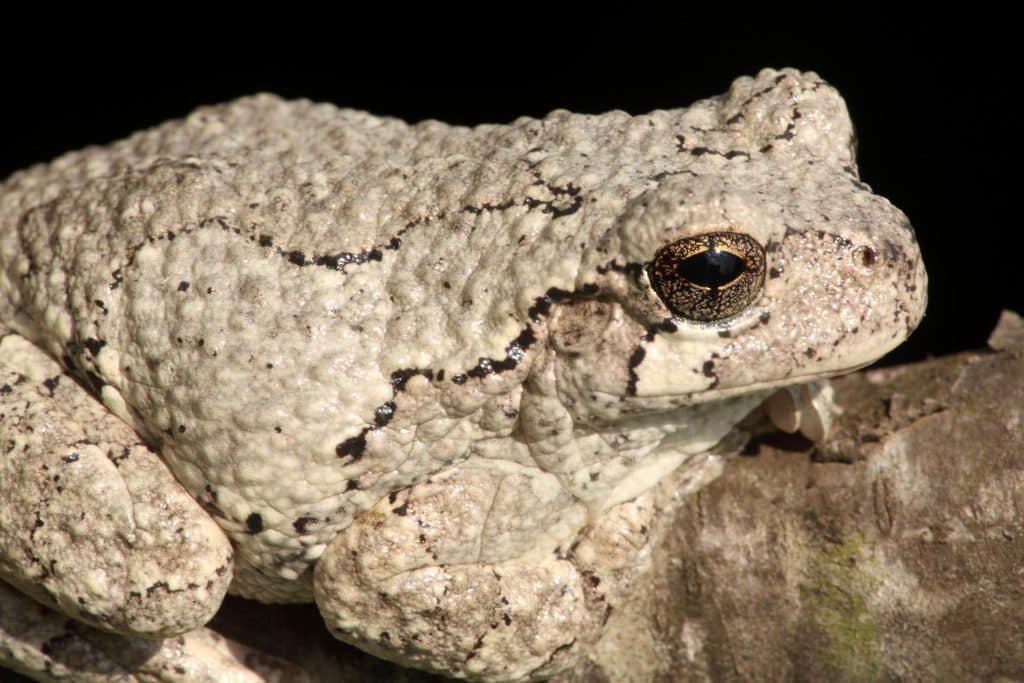
This frog’s skin still produces a slimy mucous layer, which is one of many reasons that they’re frogs and not toads.
Gray Tree Frog Temperament and Behavior
Gray tree frogs are active, arboreal animals.
During the day, they sleep on elevated branches and foliage. They’re often in plain sight and even direct sunlight – but good luck finding them!
They rely on their excellent camouflage to remain hidden in the open. Their colors change to match their surroundings.
Fun Fact: Gray tree frogs can change their color to match their surroundings in mere seconds! They do so by moving pigment and reflective plates within cells called chromatophores. The process is known as metachrosis.
At night, these tree frogs utilize their excellent eyesight for hunting down insects and other invertebrates. They’re active hunters that aren’t afraid to pounce from branch to branch.
These strictly arboreal frogs only leave their elevated refuges during the breeding season (which is also when you hear them the most) and to hibernate.
Native Range and Habitat
Gray tree frogs inhabit most of the eastern United States and southeastern Canada:
- As far north as Quebec
- As far east as the Atlantic coast
- As far south as northern Florida
- As far west as central Texas
Generally speaking, the eastern gray tree frog inhabits the northeastern part of their range. The Cope’s gray tree frog is more common in the south.
More studies are needed to determine where their ranges overlap. For example, both species share breeding ponds in Wisconsin and Michigan.
Diet
Tadpoles: Algae, detritus (decaying organic matter)
Froglets (Young Frogs): Mites, plant lice, spiders, ants, snails, and other small invertebrates
Frogs: Invertebrates, tadpoles, salamander larvae, and other tree frogs
Did You Know? Scientists have found that gray tree frogs don’t hunt for aquatic prey even during the breeding season. This finding emphasizes the importance of maintaining terrestrial habitats surrounding bodies of water. The same behavior is likely true for all North American tree frogs.
Toxic Secretions
Like most amphibians, gray tree frogs secrete a defensive skin toxin.
Their poisonous mucus is not medically significant to humans.
The irritating toxin can cause discomfort if it comes into contact with your lips, eyes, or nostrils. Even open cuts may become irritated.
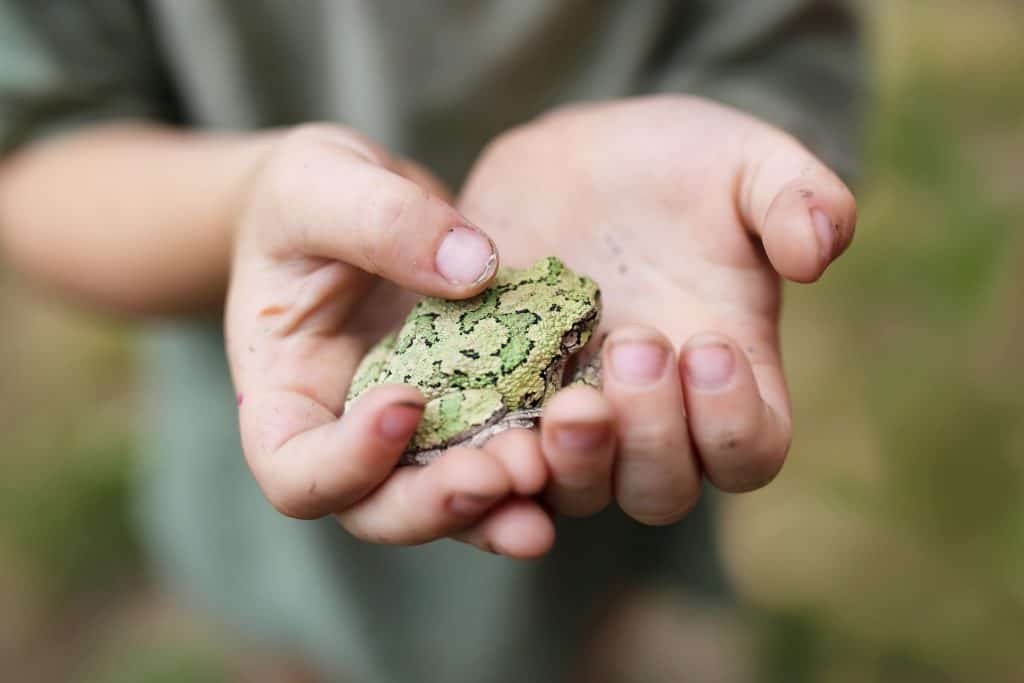
As long as you follow these two general rules, you won’t need to worry:
- Don’t handle wildlife unnecessarily. It’s best to observe wild animals without disturbing them. The frog’s mucus isn’t the only thing to worry about. Holding wild animals causes unnecessary stress. They burn their much-needed energy reserves in an attempt to escape. The oils and chemicals on our human skin can even harm them!
- Always wash your hands after coming into contact with any animal. This rule is well-known and self-explanatory. It’s especially imperative when it comes to handling amphibians.
Hibernation
Gray tree frogs survive harsh northern winters by hibernating. Their winter survival tactics are out of this world!
When the temperature starts dropping, gray tree frogs search for suitable hibernacula. Hibernacula are shelters where creatures hunker down during their winter dormancy.
These frogs prefer tree holes, hollows in tree roots, and underground burrows for hibernation. They may also burrow underground in the forest floor.
The hibernacula protect them from drafts, predators, and sudden temperature changes.
As temperatures become frigid, gray tree frogs produce a substance called glycerol. It decreases the freezing point of their bodily fluids.
In the most extreme cold snaps, 80% of the tree frog’s body freezes. Their eyes become opaque, and their breathing and heart rate stop altogether.
Gray tree frogs can survive in that state for up to seven consecutive days. The degree of their biological suspension adjusts as the temperature naturally rises and falls.
Gray tree frogs emerge from hibernation in early Spring. They immediately begin hunting to build up energy for mating season.
Life Cycle
Like most frogs, gray tree frogs undergo a developmental process known as metamorphosis.
Eggs: Each female gray tree frog lays roughly 1,800 eggs in late April or early May. The tadpoles hatch in three to seven days.
Tadpoles: Gray tree frog tadpoles consume detritus (rotting waste and debris) and algae. They mature into froglets in six to eight weeks. They’re approximately half an inch long when they morph.
Froglets: Gray tree froglets immediately adapt to an arboreal lifestyle after emerging from the water. They begin eating small insects until fall when they must begin their first hibernation. They reach sexual maturity in one to two years.
Adult Frogs: Immediately after hibernation, adult frogs work on finding food and regaining their energy. A month or two later, the males begin to call to the females. Breeding calls may continue into June or July. The female frog will find the male with the longest and most frequent calls. Once he notices her, his vocalizations change from an “advertisement call” to a “courtship call.” They’re longer and quieter. Once the male and female are within each other’s vicinity at the edge of a body of water, they enter amplexus and deposit their eggs.
Communication
One critical difference between the eastern gray tree frog and the Cope’s gray tree frog is their call.
The common gray tree frog has a resonant, musical, slower trill. It usually lasts half a second to three seconds. It’s similar to the American toad’s call.
The cope’s gray tree frog has a faster, higher-pitched trill.
In both species, the rate of the trill increases as the temperature rises. Distinguishing these closely related species is anything but easy (at least for us humans)!
Thanks to the call differences, female frogs are typically only attracted to calls of the same species.
Male gray tree frogs compete with each other for the loudest and most frequent call. Sometimes, they even try to “compete” with thunderstorms!
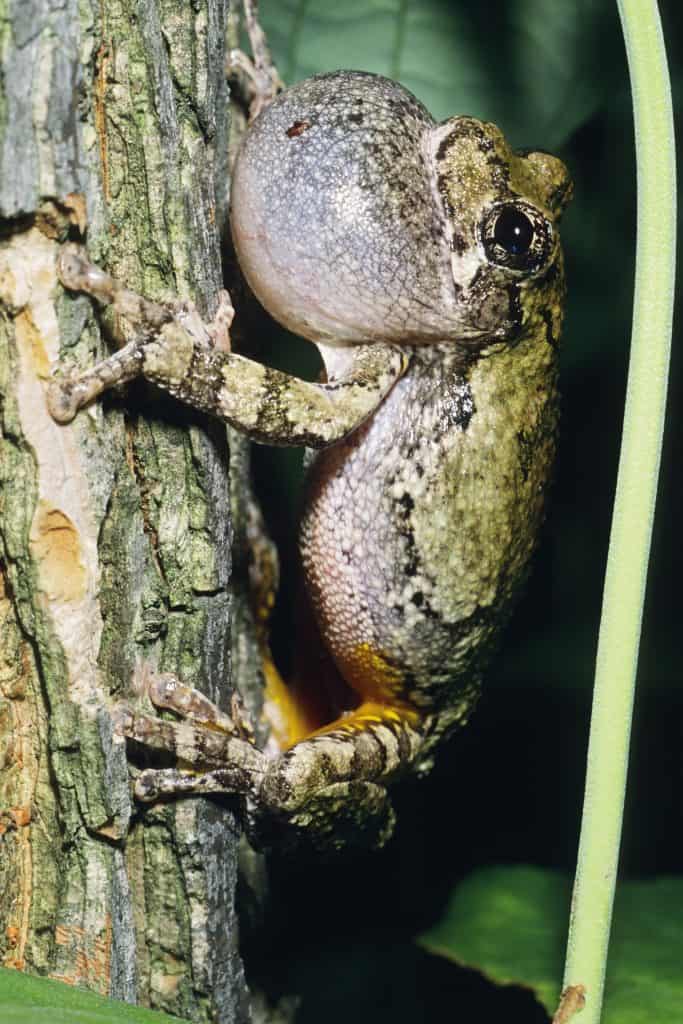
While they primarily call at night, some (potentially desperate) males will call during the day.
Gray tree frog tadpoles also have a unique way of communicating.
Injured tadpoles release a particular substance when they’re injured or killed. When other tadpoles detect that scent, they know to move away from the area.
Tadpoles are also able to detect potential predators using chemoreception.
Significance in the Ecosystem
Tadpoles occur in huge numbers in the Spring. They’re capable of eating enough algae to alter the microbiome. They also serve as an important food source for aquatic predators, like fish.
As adults, gray tree frogs help to keep the populations of mosquitoes and flies in check. Adult gray tree frogs are an important food source for predatory birds, raccoons, and oppossums.
Gray Tree Frog Husbandry
As far as frogs go, you won’t find any that are much easier to care for than the gray tree frog.
Still, taking care of a frog is a lot different than taking care of a dog or cat. Don’t worry! You’ll be a gray tree frog expert after reading our guide.
Do Gray Tree Frogs Make Good Pets?
Gray tree frogs make great pets for novice amphibian keepers.
The everyday animal lover should accept and understand that:
- Frogs aren’t cuddly or affectionate
- Frogs are a “look but don’t touch” pet
- They may be loud – especially at night during the breeding season
- Gray tree frogs are nocturnal, so there won’t be much to observe during the day
As long as any prospective gray tree frog owner accepts those drawbacks, there are many benefits to caring for this species:
- They’re so cute!
- They’re low maintenance compared to many other exotic pets.
- They can live comfortably in small enclosures, thanks to their small size.
- Gray tree frogs are an excellent opportunity for amphibian enthusiasts to familiarize themselves with the unique world of frog ownership.
Where to Buy a Gray Tree Frog
It’s surprisingly tricky to source captive-bred gray tree frogs. Reptile dealers find it more affordable to buy them from wildlife collectors than dedicated hobby breeders.
To further complicate matters, gray tree frogs aren’t popular in captivity.
Their simplistic beauty is easy to overlook in the ocean of more colorful and exotic frogs. No one seems to mind that those frogs are also MORE expensive, MORE fragile, and HARDER to care for.
Don’t lose hope: you may be able to connect with a dedicated breeder in online forums.
If not, and you’re determined to have a gray tree frog, consider the moral dilemma of plucking a wild animal out of its environment.
Since wild gray tree frogs are so prevalent and adaptable, there’s no shortage. They do adjust well to life in captivity. Still, this is not a moral boundary that every animal lover would cross.
Expert Tip: If you can’t bear the thought of removing a real gray tree frog from the wild, consider a frog plush to fill the hole in your frog-loving heart.
Consider, also, the implications of subjecting the animal to the stress of – and paying for – shipping.
As long as you live in their native range, it may be more logical and humane to catch your gray tree frogs. They’re easy to find along bodies of water during the springtime.
Supply List
- Substrate
- Water dish
- Hiding spots
- A steady supply of small, live insects
- Glass enclosure (at least 12” x 12” x 18”)
- Misting spray bottle or automatic misting system
- Natural or synthetic branches, perches, and plants
Enclosure Size and Style
Minimum Enclosure Size: 12” x 12” x 18” (L x W x H)
As arboreal (tree-dwelling) frogs, cage height is the priority. Any habitat you select should be at least 18” tall.
Floor space that’s at least 12 inches long by 12 inches wide is adequate for one adult frog. Add at least six inches for each additional frog.
The most affordable habitat choice is a standard glass aquarium. They’re available at any pet store and, often, garage sales and resale websites. A 20-gallon aquarium is a great starting point.
Be sure to purchase a tight-fitting lid and clips for an aquarium.
Front-opening terrariums are even better, but they’re pricier. The side doors are ideal for arboreal animals that may attempt to flee out of an open top – like gray tree frogs.
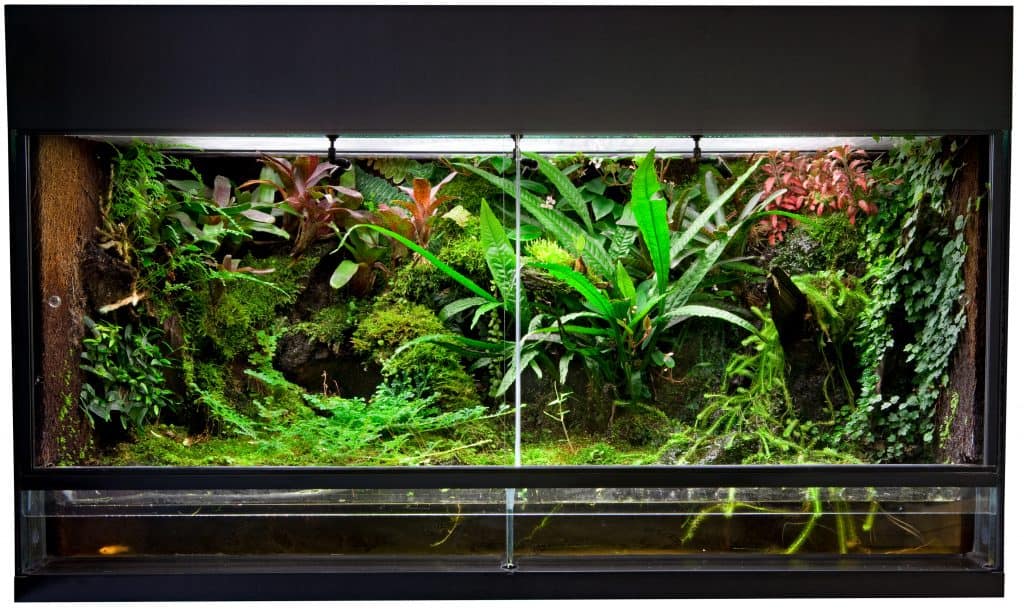
Expert Tip: For the DIY-ers at heart, you could also try repurposing old furniture into a frog habitat. Gray tree frogs’ modest humidity requirements are perfectly suited for conversion projects.
Lighting
Ideal Lighting Schedule: 12 Hours Light/12 Hours Dark
Gray tree frogs are nocturnal. They’re active at night and sleep during the day.
As with any living creature, it’s best to expose gray tree frogs to some type of light. The light can come from a window, ambient household lighting, or a dedicated lamp.
Without light exposure, your gray tree frog can’t maintain a proper day and night cycle. Without that natural cycle, animals may become stressed or even sick.
In the wild, gray tree frogs sleep in the open – often in direct sunlight.
It’s worth considering equipping your frog’s habitat with an appropriately-powered UVB fluorescent light.
Most living creatures benefit from UVB exposure, whether from artificial lighting or natural sunlight. Biologists have extensively studied – and proven – the benefits of UVB for reptiles and amphibians.
In terms of daytime duration, a 12-hour schedule is easy to follow and well-tolerated. You could even set the light timer to mimic seasonal sunset and sunrise times!
Heating
Ideal Temperature: 68-78°F (20-26°C)
Most captive gray tree frogs won’t need supplemental heating. Room temperature is perfect.
Gray tree frogs can survive freezing temperatures. They’re most comfortable and healthy when the temperature stays above 68°F (20°C).
To keep your gray tree frog comfortable and healthy during the winter, you may need to provide a low-wattage incandescent light bulb.
Always turn the light off at night. Constant light will stress your frog. Nighttime temperature drops are healthy.
Ensure that there are ways for your frog to escape the heat and light. The light should only ever encompass half of the habitat, at most.
Water and Humidity
Ideal Humidity: 50-80%
Always use an aquarium water conditioner to treat any water that will come into contact with your frogs.
Frogs have highly permeable skin, making them susceptible to pollutants in their environment – including their water and the cleaning supplies you use.
Tap water, and even some bottled waters, may contain harmful components. Water conditioners remove heavy metals, chlorine, and chloramine.
In terms of amphibians, gray tree frogs are surprisingly drought-tolerant. As previously stated, they even sleep in direct sunlight! They’re tough cookies.
It’s best to fine-tune your ventilation and misting routine so that the humidity spikes up to 80%. Then, it should gradually drop to 50-60% until you spray it again.
That cycle should take place every 24 hours.
If the humidity doesn’t fall to at least 60% in 24 hours, increase ventilation in the enclosure. Consider adding more holes, more mesh openings, or installing small computer fans.
Harmful bacterial and fungal microorganisms thrive in damp, stagnant air. Fresh air is imperative for your frog’s health and wellbeing.
Always keep a shallow, wide water dish filled with fresh, treated water. Gray tree frogs enjoy soaking occasionally. Change the water once a day and wash the bowl at least once a week.
If you’re having a hard time keeping the humidity above 50%, consider a terrarium waterfall. The constant water flow and aerosolized droplets naturally raise humidity levels.
Decor and Environmental Enrichment
Here’s the fun part: decorating! Mental stimulation! Environmental enrichment! Froggy hide-and-seek!!!
Your goal here is to create an environment that offers opportunities for:
- Hiding
- Hunting
- Sleeping
- Exercising
- Alone time away from cage-mates
Their sticky toe-pads allow gray tree frogs to climb smooth surfaces, including glass. You can increase usable space by adding perches, such as:
- Branches
- PVC Pipes
- Cork rounds
- Living plants
- Artificial vines
- Bamboo poles
- Magnetic ledges
You may also consider purchasing a magnetic feeding ledge to hold larval insects.
If you want to create a naturalistic-looking habitat, consider a terrarium background and a fine particulate substrate from the list below.
Your gray tree frog will surely appreciate the novel textures.
Substrate
Good Substrates:
- Foam liner
- Coconut fiber
- Organic topsoil
- Sphagnum moss
- Large river rocks
- Moist paper towels
Bad Substrates:
- Bark
- Sand
- Reptile carpet
- Coconut husk
- Wood shavings
- Aquarium gravel
Be wary of any small, chunky substrate. Enthusiastic frogs may ingest pieces while hunting. If they’re not small enough to pass, they’ll cause an obstruction – leading to death.
Cohabitation
Gray tree frogs are solitary creatures. In the wild, they only come together to mate. Males may even become territorial with other males.
Still, as with most tree frogs, cohabitation doesn’t seem to cause many issues. Be sure that the frogs are the same size and, preferably, all females.
Don’t house more than one male in a group. While they probably won’t physically fight, it will stress them unnecessarily.
Breeding
Wild gray tree frogs use seasonal changes as triggers for reproduction.
In captivity, it’s difficult to replicate the cold winters and rainy springs that gray tree frogs experience in the wild.
Keeping a pair of gray tree frogs in the same conditions year-round rarely, if ever, results in successful reproduction.
Their mating requirements contribute to the rarity of captive-bred animals.
Many keepers who successfully breed gray tree frogs place their enclosures outdoors during the winter. Gray tree frogs can handle freezing temperatures by hibernating.
If you decide to pursue this technique – research, research, and research more!
Frogs stuck in an enclosure aren’t able to go out and find an ideal hibernation spot. They also shouldn’t experience sudden temperature changes.
Another idea involves using a wine cooler controlled by a thermostat. You can gradually drop the temperature and ensure conditions don’t become extreme.
Generally speaking, temperatures should drop to 45-60 for two to four weeks. Reducing their days to 10 hours of light may also help.
After four weeks, you can start replicating springtime changes:
- Mist the enclosure more often
- Raise the temperature to 75-85
- Increase daylight to 12 to 14 hours per day
If all goes well, your male will begin calling. Your frogs will descend to their water dish and join in amplexus. The female will deposit her eggs in the water dish, where the male will fertilize them.
Tadpole Care
Remove the eggs to a larger container of treated water. They should hatch in 48 to 72 hours. Over the next seven days, they’ll absorb their yolk.
Tadpoles only swim after they’ve absorbed their yolk. At this time, you should feed them aquatic tadpole food or crushed fish flakes. Feed them every day.
Change 50% of the water every other day. Again, we stress the importance of treating water before exposing your frogs (or tadpoles) to harmful chemicals.
Gray tree frogs lay hundreds of eggs! You may find it more manageable to split them into smaller groups and containers as they grow.
Once the tadpoles develop hind legs, add a way for them to access dry land.
You could tilt their container, so the water stays on one side. Another method involves stacking rocks to form an island.
The entire process, from egg-laying to metamorphosis, should take three to four months.
Once they crawl onto dry land, you can move the froglets into a terrarium. Feed them flightless fruit flies and pinhead crickets.
Gray Tree Frog Diet and Feeding Guidelines
Gray tree frogs are insectivores that only eat live insects. Offering a variety will help to account for the nutritional shortcomings of captive-raised bugs.
Captive Food Options
Staples:
- Flies
- Crickets
- Roaches
- Fruit flies
- Silkworms
- Hornworms
- Earthworms
Occasional Treats:
- Waxworms
- Mealworms
- Butterworms
- Superworms
- Black soldier fly larvae
- Wild-caught insects (ex. Grasshoppers, moths, etc.)
Amount
Quantity: 3-6 appropriately-sized insects
Gray tree frogs have a notoriously huge appetite. They’ll eat themselves into obesity. As their caretaker, your job is to ensure that they stay slim and healthy.
Your frog’s meals should consist of no more than six appropriately-sized insects. They shouldn’t be any longer than the space between your frog’s eyes.
Frequency
Adults: Every 2-3 days
Froglets: Every day
Techniques
As we previously stated, offering your frog a variety of insect species will help bridge any nutritional gaps.
Just like you wouldn’t get all of your nutritional needs met by eating only apples, you can’t expect to cover all of your frog’s nutritional needs with only crickets.
Most experienced frog keepers recommend starting with a base diet of crickets because they’re high in protein and low in fat. Offer a novel insect for every third meal.
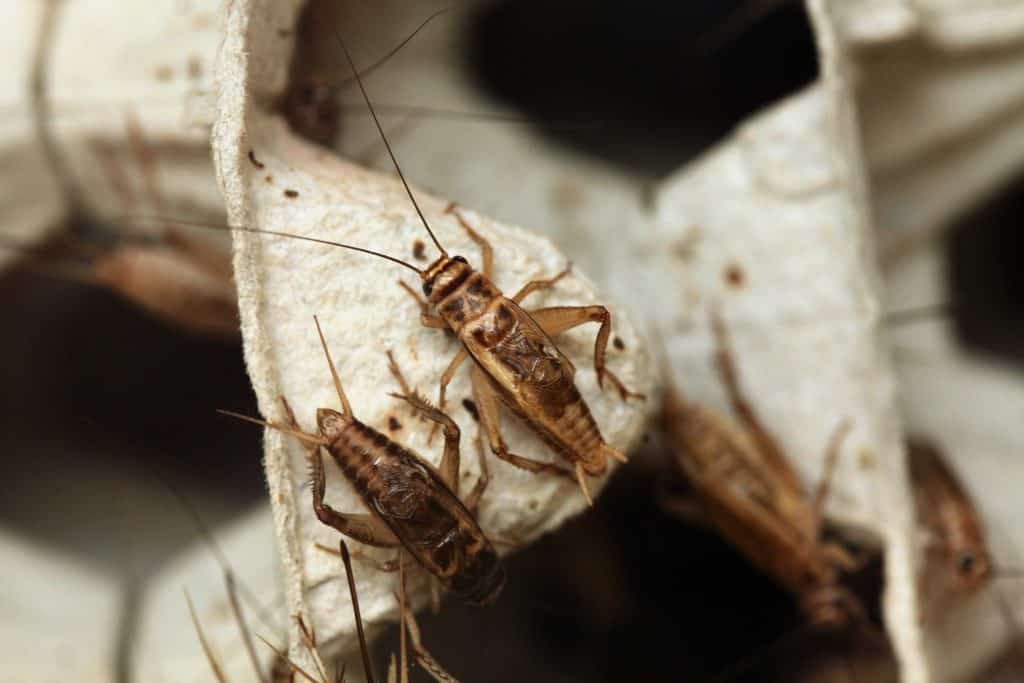
Where possible, consider gut-loading the feeder insects. Gut-loading involves feeding nutrient-rich food to the insects for at least 24 hours before feeding them to your frog.
“You are what you eat.”
If an insect’s digestive tract is full of healthy, calcium-rich food, your frog will reap the benefits of those micronutrients.
With mobile insects, like roaches and crickets, mealtime presents an opportunity for exercise. If you release the bugs into the habitat, your frog will hunt.
Unfortunately, it’s difficult to monitor your frog’s intake this way, especially if they live in a group. Insects also have the chance to dig into the substrate or escape.
Some frog owners opt to feed their frog with rubber-tipped feeding tongs.
You can offer grubs, like mealworms and silkworms, in an escape-proof feeding dish. Most arboreal frogs prefer to eat from elevated food dishes.
Supplements
Dust feeder insects with a reptile calcium powder at least once a week or as often as every other meal.
If you’re using a UVB lamp, ensure the calcium doesn’t contain Vitamin D3.
If there is no natural sunlight exposure or UVB lighting, ensure the calcium does contain Vitamin D3.
Dust feeder insects with a reptile multivitamin powder once every other week.
Gray Tree Frog Health and Wellness
Reptiles and amphibians are notoriously skilled at hiding any signs of disease, so monitor changes closely.
Signs of a Sick Gray Tree Frog
- Bloating
- Swelling
- Inactivity
- Weakness
- Weight loss
- Cloudy eyes
- Skin lesions
- Open-mouth breathing
Internal Parasites
Prevention:
- Avoid feeder crickets
- Avoid wild-caught feeder insects
Symptoms:
- Lethargy
- Weight loss
- Bloody or mucosal stools
- Easily wounded with delayed healing
Treatment:
- Oral or injectable antiparasitics
- Veterinary diagnosis and treatment is highly advised
Ranavirus
Prevention:
- Quarantine new amphibians in a different room
- Don’t share equipment between existing frogs and new frogs
- Wash hands between handling different groups of amphibians
Symptoms:
- Lethargy
- Weight loss
- Eye problems
- Reddening skin
- Ulcers and sores
- Limbs begin wasting away
- Bleeding from mouth or vent
Treatment:
- None (euthanasia recommended)
Chytrid Fungus
Prevention:
- Quarantine new amphibians in a different room
- Don’t share equipment between existing frogs and new frogs
- Wash hands between handling different groups of amphibians
Symptoms:
- Lethargy
- Peeling skin
- Discolored skin
- Loss of appetite
Treatment:
- Veterinarian-prescribed antifungals
Signs of a Healthy Gray Tree Frog
- Active and alert
- Healthy weight (not bony)
- Skin free of lesions and covered in healthy mucous
Veterinary Care
It’s challenging to find a veterinarian that’s willing to and has experience with treating exotic pets. It’s even more difficult to find a veterinarian that can work on amphibians, in particular.
Luckily, the Association of Reptile and Amphibian Veterinarians has a “Find a Vet” tool. We advise you to find an amphibian-friendly veterinarian before you need one.
Shedding
Shedding is a normal process for reptiles and amphibians. It helps animals heal, get rid of parasites, and grow. In the case of frogs, shed skin also offers a nutritional boost.
It’s completely normal and healthy for your gray tree frog to eat its shed skin! The process is truly fascinating to watch.
Gray Tree Frog Handling and Bonding Tips
When it comes to gray tree frogs and amphibians generally, there aren’t many opportunities for handling and bonding.
The oils and chemicals found on our skin can actually harm amphibians! The more frequent and longer the duration of exposure, the more the animal is at risk.
Limited handling on an as-needed basis (ex. Escape attempts, veterinary trips, switching enclosures) shouldn’t cause issues.
Otherwise, attempt to bond with your frog by observing it while it explores its habitat and offering insects from blunt feeding tongs.
Naming your frog is another great way to feel closer and bonded.
Further Froggy Facts
Diet is the primary cornerstone of your frog’s health – and interaction opportunities!
Check out our comprehensive frog diet guide to learn more about feeding your gray tree frog a healthy, complete diet.
If you’re still “hopping” to absorb more information, did you know these six key differences between reptiles and amphibians?
We’d love to hear all of YOUR favorite froggy facts – or questions – in the comment section below.
